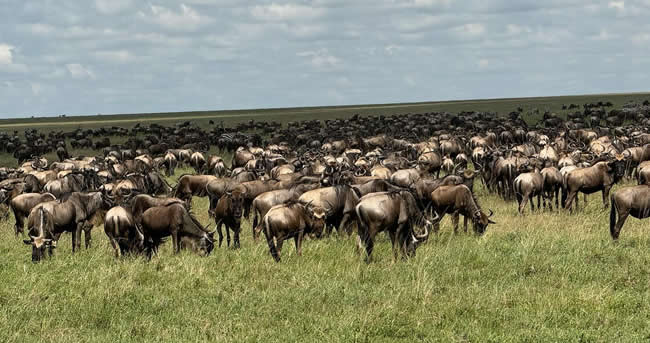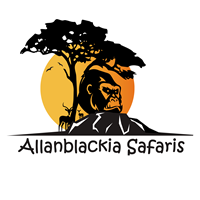The Great Migration in Kenya is without doubt the most captivating wilderness experience not to be missed. The wildebeest migration is the most powerful annual event in Kenya safari history and is a special event where more than 1.5 million wildebeest embark on a journey to search for what to feed on. During the migration, millions of the wildebeest are escorted by 1000s of zebras, elands, and Grant and Thompson’s gazelles.
The Great Migration in Kenya marks the world’s largest mammal trek in the wild and follows the rain patterns. The movement can take about 800 km and usually, it follows a clockwise pattern in the Serengeti-Masai Mara ecosystem. Wildebeests move in search of greener pasture and water.
The Kenya wildebeest migration begins from June traveling clockwise from the vast Serengeti plains to the Masai Mara from July, August, September to October. The Mara migration is one of a one-of-a-kind moment when it comes to the Great Migration. Booking a Great Migration tour with Allan Blackia Safaris within this period allows you to enjoy the most thrilling wildlife encounter of a lifetime. A huge concentration of wildebeest forcefully moves in the crocodile-infested Mara River to cross to the main. As they cross, lots of the cats can be impatiently waiting around to catch their prey for the day.

Best months to witness the Great Migration
The best months to enjoy the most thrilling wildebeest migration is from July, August, and September to October. These are the months when a large population of these mammals crosses from the Serengeti Game Park in Tanzania to Kenya’s Mara Reserve. The best months to encounter the Great Migration River crossing is from mid-June to November.
January, February & March movement
January usually marks the end of the migration to the southern part as they head towards the Eastern Serengeti and the Ngorongoro Conservation Area. These areas often feature abundant grass/pasture for wildebeest to depend on and is an ideal wildebeest calving period. These mammals need adequate pasture to depend on during the birthing period and about 8000 calves are born each day. Witnessing the wildebeest calving session is a special event of its own.
April-May
The Great Migration heads to the newer-grown grass in the Central Serengeti. 1000s of wildebeest together with other plain game confine in the area. Around May, these mammals move miles and miles for mating. It is around this month when the mating season starts and is an ideal period to watch the male as they battle for dominance. Slowly by slowly, the wildebeest movement begins to assemble in the western corridor of Serengeti, confining themselves along the Grumeti River.
June –July
The peak dry months are marked by June and July. These are the months when a huge concentration of the wildebeest in the western Serengeti starts and also around the Grumeti River’s Southern banks. 100s-1000s of the wildebeest begin heading to the North on the western edge of Serengeti Game Park and the Mara River. Typical river crossing begins in July and the entire event is entirely unpredictable.
August-October
August, September, and October are special months too when it comes to the Great Migration experience. It is around August when the huge herds of these mammals encounter severe challenges crossing the Mara River. Besides crocodiles, there can be a lineup of other predators to be spotted as they hunt for wildebeest and other grazers. September to October mark the end of the chaos and migrating columns gradually move eastwards.
Additional safari activities to enjoy in the Masai Mara include game drives, horseback riding tours, bush walking safaris, hot air balloon safaris, cultural encounters, and others.
Where to stay during migration safaris in Kenya?
Royal Mara Safari Lodge: Set directly along the wildebeest migration route, and is an ideal spot for guests who desire to encounter the Mara River crossing. This luxury accommodation features comfortable tents in the Hippo Bend on the River Mara. Its strategic location guarantees guests jaw-dropping views of the River and Savanna grassland. The tents feature King-size beds, double vanity sinks, and desks as well as en-suite bathrooms with flush toilets. There is also a hot water shower and an electronic safe box.
Royal Mara Safari Lodge is set on 109.4 sq. mile Mara North Conservancy. Due to its strategic location, it is an ideal place to also enjoy guided walking safaris, and game drives. It is best accessible using a 4×4 safari vehicle. The room features include a seating area, clothes rack, room service, safe, extra-long beds, and bottled water.
Little Governor’s Camp: Consisting of 17 en-suite tents all tucked around an extensive watering hole. Little Governor’s Camp is among the best lodges to consider for overnight stays, especially if game viewing is your target goal in the Masai Mara.
Mara Serena Safari Lodge: Built high on a bush-cloaked hill with spectacular views of the Mara savanna. This luxury lodge comprises 74 traditionally Maasai–decorated rooms, a bar, a restaurant, and a swimming pool.
Kicheche Mara Camp: A luxury lodging facility with 8 luxury tents. Kicheche Camp is set overviewing the scenic Olare Orok stream. On the Great Migration tour in the Maasai Mara, consider this camp a must to book for an overnight stay.
Kichwa Tembo Camp: This is a luxury camp, a 40-tent camp, and has great amenities/features. They include a dining restaurant, a swimming pool, and comfortable tents for overnight stays.
Getting to Maasai Mara for great migration in Kenya.
Masai Mara Reserve is accessible by road and air. Visitors on the Kenya Migration tour can reach this reserve within 6 hour’s drive from the heart of Nairobi city. The access gates to Masai Mara include the Sekenani gate, Talek gate, Oloololo gate, Musiara, and Sand River gates, etc.
By air: Taking a flight to Maasai Mara can cut down on the number of hours if you were to go by road. Domestic flights are available and you can land in any of the airstrips in Masai Mara including Serena Airstrip, Keekorok Airstrip, Musiara Airstrip, and Ngerende Airstrip.
Ensure that the airstrip you land in is near your accommodation facility to avoid spending long hours connecting to where you plan to stay for a night and also where to begin your safari activities.
